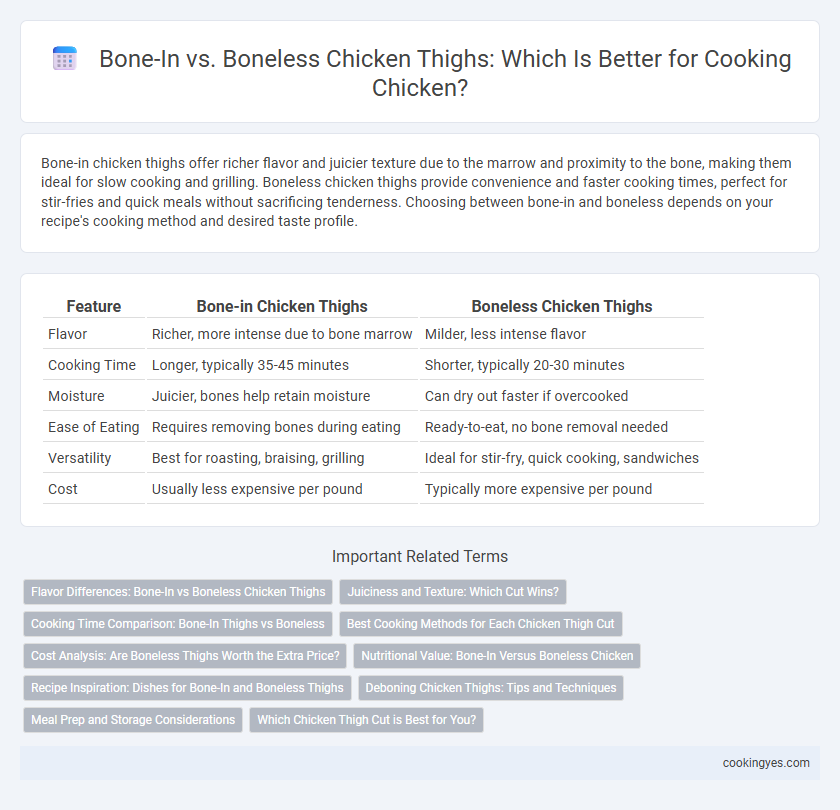Bone-in chicken thighs offer richer flavor and juicier texture due to the marrow and proximity to the bone, making them ideal for slow cooking and grilling. Boneless chicken thighs provide convenience and faster cooking times, perfect for stir-fries and quick meals without sacrificing tenderness. Choosing between bone-in and boneless depends on your recipe's cooking method and desired taste profile.
Table of Comparison
| Feature | Bone-in Chicken Thighs | Boneless Chicken Thighs |
|---|---|---|
| Flavor | Richer, more intense due to bone marrow | Milder, less intense flavor |
| Cooking Time | Longer, typically 35-45 minutes | Shorter, typically 20-30 minutes |
| Moisture | Juicier, bones help retain moisture | Can dry out faster if overcooked |
| Ease of Eating | Requires removing bones during eating | Ready-to-eat, no bone removal needed |
| Versatility | Best for roasting, braising, grilling | Ideal for stir-fry, quick cooking, sandwiches |
| Cost | Usually less expensive per pound | Typically more expensive per pound |
Flavor Differences: Bone-In vs Boneless Chicken Thighs
Bone-in chicken thighs offer richer flavor and juicier texture due to the marrow and connective tissue that enhance the meat during cooking. Boneless chicken thighs cook faster and provide convenience but often lack the depth of taste and moisture retention found in bone-in cuts. For recipes prioritizing intense flavor and tenderness, bone-in thighs remain the preferred choice.
Juiciness and Texture: Which Cut Wins?
Bone-in chicken thighs retain more moisture during cooking, resulting in juicier, more flavorful meat with a tender, slightly firmer texture due to the bone's heat distribution. Boneless chicken thighs cook faster and offer convenience, but they tend to lose more juices, producing a softer texture that can sometimes be less rich in flavor. For maximum juiciness and optimal texture, bone-in chicken thighs generally provide the winning combination favored by chefs and home cooks alike.
Cooking Time Comparison: Bone-In Thighs vs Boneless
Bone-in chicken thighs typically require 35 to 45 minutes to cook at 375degF, offering a juicier texture due to the bone retaining heat. Boneless chicken thighs cook faster, usually in 20 to 30 minutes at the same temperature, making them ideal for quick meals. Choosing between bone-in and boneless thighs affects not only cooking time but also moisture retention and flavor intensity.
Best Cooking Methods for Each Chicken Thigh Cut
Bone-in chicken thighs retain moisture and flavor during slow cooking methods like braising and roasting, producing tender and juicy results. Boneless chicken thighs are ideal for quick cooking techniques such as grilling, sauteing, or stir-frying, allowing for even heat distribution and faster doneness. Choosing the right cut based on cooking method enhances texture and taste, with bone-in preferred for extended heat and boneless suited for high-temperature, short-duration preparations.
Cost Analysis: Are Boneless Thighs Worth the Extra Price?
Bone-in chicken thighs typically cost less per pound than boneless thighs due to lower processing requirements. Boneless thighs offer convenience and faster cooking times, justifying their higher price for busy households or recipe flexibility. Examining cost per serving reveals that while boneless thighs have a premium, the reduced cooking time and ease may offset the expense in time-saving and meal preparation efficiency.
Nutritional Value: Bone-In Versus Boneless Chicken
Bone-in chicken thighs retain more minerals like calcium and phosphorus due to the presence of marrow and connective tissue, contributing to enhanced nutritional benefits. Boneless chicken thighs typically have a slightly lower calorie content and less fat, making them a leaner option for those monitoring dietary intake. Protein levels remain comparable in both bone-in and boneless cuts, ensuring adequate nutrient supply regardless of the choice.
Recipe Inspiration: Dishes for Bone-In and Boneless Thighs
Bone-in chicken thighs offer richer flavor and moisture, ideal for slow-cooked dishes like coq au vin or braised stews that benefit from extended cooking times. Boneless chicken thighs provide convenient versatility for quick recipes such as stir-fries, grilled skewers, or crispy fried bites, allowing for faster marination and even cooking. Choosing between bone-in and boneless often depends on the recipe's cooking method and desired texture, with bone-in preferred for depth of taste and boneless favored for ease and speed.
Deboning Chicken Thighs: Tips and Techniques
Deboning chicken thighs requires precise knife skills to separate the meat from the bone while preserving the thigh's integrity and maximizing yield. Start by placing the thigh skin-side down, cutting along the bone, and carefully scraping the meat away using a sharp boning knife or fillet knife. Proper deboning technique not only enhances cooking versatility but also ensures even cooking and better flavor absorption when preparing boneless chicken thigh recipes.
Meal Prep and Storage Considerations
Bone-in chicken thighs retain more moisture and flavor during cooking, making them ideal for meals that benefit from juicy, tender meat. Boneless chicken thighs offer faster cooking times and require less refrigeration space, simplifying meal prep and storage logistics. For long-term storage, boneless thighs freeze more evenly and defrost quickly, reducing the risk of uneven cooking.
Which Chicken Thigh Cut is Best for You?
Bone-in chicken thighs offer richer flavor and retain moisture better during cooking, making them ideal for slow roasting and braising. Boneless chicken thighs cook faster and are more versatile for stir-fries, grilling, and quick meals, appealing to those seeking convenience. Your choice depends on whether you prioritize taste and texture or speed and ease of preparation.
Bone-in vs Boneless for Chicken Thighs Infographic

 cookingyes.com
cookingyes.com